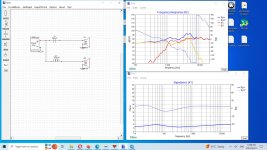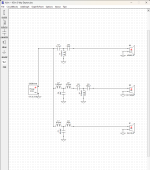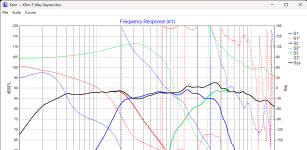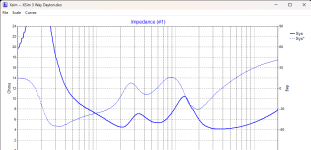Just FYI. Two years after downloading Xsim my virus scan tools are lighting up and flagged xsimsetup.exe as malware (the file is located in my downloads folder from 2021). Is there a credible source for downloading or is this a false positive?
https://www.virustotal.com/gui/file/7ec7754e2c246c457c9e5ef2d02967544dc281398cc8c6cb1dda74f14f536928
https://www.virustotal.com/gui/file/7ec7754e2c246c457c9e5ef2d02967544dc281398cc8c6cb1dda74f14f536928
Ok well i feel quite dumb about this but literally been banging my head against the wall with this issue for days now . Just got into xsim and trying to practice with Dayton FRD ZMA files whatever i do the frequency response graph on the software doesnt change beyond initial FRD ZMA loading of two drivers data. I have tried to copy whats in tutorials tried various drivers but no value change of any inductor/ capacitor does not change the frequency response in software. Im not an electrical engineer but i have followed simple tutorials from youtube and still same issue. same in vituixCAD.
Attachments
thats it ! cheersMaybe you just placed the parts on the exisiting connection. This does not automatically connect them, you must route the connections freshly.
Hey Guy's
Newbro here, my first diy project.
Using XSim for the crossover. Got my head around the basics, but the fine tuning is eluding me. It's not the ugliest frequency response graph I've come across, but nor is it the smoothest. My choice of drivers obviously plays a role here, but I want to put it out there, have you guy's evaluate and recommend improvements.
I've attached the XSim file for evaluation.
Newbro here, my first diy project.
Using XSim for the crossover. Got my head around the basics, but the fine tuning is eluding me. It's not the ugliest frequency response graph I've come across, but nor is it the smoothest. My choice of drivers obviously plays a role here, but I want to put it out there, have you guy's evaluate and recommend improvements.
I've attached the XSim file for evaluation.
Attachments
Nice work SB, I would try to tune the overall balance so that there is about a -3dB to -5dB right-downwards tilt of the overall response from 100Hz to 20kHz for a more pleasing sound that won't sound fatiguing after an hour. This response curve is sometimes called the "Harman House Curve" - developed by Harman (JBL et al) through much in-house study. I also find that it makes for a pleasant sounding speaker. Speakers voiced for a "flat" response can sound harsh after some listening time. It is personal preference how much tilt you like and some people don't have any and aim for flat "monitor" like response.
Cheers xrk, you sent me down a rabbit hole re responses, had always assumed flat was the goto, but it's a complicated subject, very dependent on equipment and room, but theoretically I like the idea, as I lean towards the low and low mid frequencies, so this approach seems to fit well with what I want to get out of the speakers. Having said that, I'll probably build two prototypes, flat vs hhc, the deciding factor being my ears 
The latest FR graph relects your thoughts, about a -5dB tilt, and I've cleaned it up somewhat, but I won't get too excited until you guy's give it your stamp of approval, or if it's not quite there yet, be clear in the advice moving forward, as I'm really at the limit of my knowledge here, my brains about to explode :I


The latest FR graph relects your thoughts, about a -5dB tilt, and I've cleaned it up somewhat, but I won't get too excited until you guy's give it your stamp of approval, or if it's not quite there yet, be clear in the advice moving forward, as I'm really at the limit of my knowledge here, my brains about to explode :I
If you manage to pull this off in the real world you have accomplished no small bit of crossover work. The only things you should be chasing now is off axis horizontally and vertically (vertical is not as much of a worry as long as you are simulating it correctly).but I won't get too excited until you guy's give it your stamp of approval, or if it's not quite there yet, be clear in the advice moving forward, as I'm really at the limit of my knowledge here
Mark
In general terms, it turns out that, not unexpectedly, a flat, uncolored on-axis response is desirable, and the work of Toole has supported this. Some relevant details are provided in an Open Access journal paper, The Measurement and Calibration of Sound Reproducing Systems....re responses, had always assumed flat was the goto, but it's a complicated subject, very dependent on equipment and room, but theoretically I like the idea, as I lean towards the low and low mid frequencies, so this approach seems to fit well with what I want to get out of the speakers.
The importance of a flat on-axis response has been reiterated by Toole: "From the beginning, loudspeakers intended for sound reproduction have been designed with the goal of a flat on-axis frequency response so that the first sound to arrive is an accurate representation of the spectrum of the recorded sound. Double-blind subjective evaluations of loudspeakers conducted by the author and his colleagues for 35 years have shown consistent preference for those having flat and smooth on-axis frequency response, accompanied by well-behaved off-axis response—i.e., a smoothly changing or constant directivity index."
Toole also noted that "the direct sound has a high priority in perception, establishing a reference to which later arrivals are compared in determining such important perceptions as precedence effect (localization), spatial effects, and timbre."
The –5dB tilted on-axis response that you have achieved would typically be the target for the in-room response of the loudspeaker. This takes in the effects of early reflections and the directivity (directionality) of the midrange and tweeter loudspeaker drivers. I would expect the present design iteration to produce a sound that is quite lacking in high frequencies, with a more distant presentation of voices.The latest FR graph relects your thoughts, about a -5dB tilt, and I've cleaned it up somewhat, but I won't get too excited until you guy's give it your stamp of approval, or if it's not quite there yet, be clear in the advice moving forward, as I'm really at the limit of my knowledge here, my brains about to explode
You have succeeded in creating a crossover that matches your desired target-response curve. Hence, I think that it won't be too difficult for you to revisit the design and aim for a much flatter on-axis response. I look forward to seeing your results if you decide to do so.
If I may make a small suggestion, I'd like to see the frequency labels shown on the plot. It makes it a bit easier to get one's bearings when looking at the presented results.
Vertical is VERY important because it helps verify that you have the forward lobe pointed toward your listening position height, if that makes sense.
I once managed to design a nicely measured horizontal axis, but the forward lobe was pointed at the floor. When I was in my seated position I was listening in the crossover suck out. It was some dodgy measurements I'd done that was the cause.
Wayne Parham has a great video on his forum about this...
https://audioroundtable.com/forum/index.php?t=msg&th=12067
Like Mark said, so long as you're simulating correctly you should be fine. I'd add to that by saying so long as you measured and simulated correctly, but for me the measurements of the final build are the only way to know for sure.
Good luck.
I once managed to design a nicely measured horizontal axis, but the forward lobe was pointed at the floor. When I was in my seated position I was listening in the crossover suck out. It was some dodgy measurements I'd done that was the cause.
Wayne Parham has a great video on his forum about this...
https://audioroundtable.com/forum/index.php?t=msg&th=12067
Like Mark said, so long as you're simulating correctly you should be fine. I'd add to that by saying so long as you measured and simulated correctly, but for me the measurements of the final build are the only way to know for sure.
Good luck.
Last edited:
Cheers Mark, not sure how to approach simulating the horizontal and vertical axis, it's another rabbit hole I need to go down. I was hoping not to think about it, but let's get this right, no shortcuts 👍
Mazza, reading that post you linked and many others to try to wrap my head around the subject.
witwald, I appreciate the input, and you're not wrong as 99% of professional engineers chase that elusive flat curve, but then they have to because they have to design a product that will reproduce any genre of music. It's not just about reproducing the master as it was intended, genre's and personal prefernce come into play. I primarily listen to 60's/70's rock/prog rock, throw in some Tool, then 90's EDM, and having an emphasis towards drums and base guitar. Some audio engineers setting up PA's to accomodate those genre's/instruments, add xdB to the low frequencies, so I've simply tried to reflect that in the crossover. I was originally chasing the flat curve because I wasn't sure how to approach what I actually wanted, but when xrk suggested a -5dB tilt, that's all the encouragement I needed. To your final point though, have I over done it, is -5dB too much, maybe, but the only reason I ran with this figure is that the aforementioned audio engineers tend to bump up the low frequencies by 5-6dB, so there appears to be some correlation, either that or I'm just reading into something that has no relationship with the other. However, I do recognise that setting up a home HiFi is vastly different from a PA, but I'm learning as I go, and it's a fun ride 😎
Mazza, reading that post you linked and many others to try to wrap my head around the subject.
witwald, I appreciate the input, and you're not wrong as 99% of professional engineers chase that elusive flat curve, but then they have to because they have to design a product that will reproduce any genre of music. It's not just about reproducing the master as it was intended, genre's and personal prefernce come into play. I primarily listen to 60's/70's rock/prog rock, throw in some Tool, then 90's EDM, and having an emphasis towards drums and base guitar. Some audio engineers setting up PA's to accomodate those genre's/instruments, add xdB to the low frequencies, so I've simply tried to reflect that in the crossover. I was originally chasing the flat curve because I wasn't sure how to approach what I actually wanted, but when xrk suggested a -5dB tilt, that's all the encouragement I needed. To your final point though, have I over done it, is -5dB too much, maybe, but the only reason I ran with this figure is that the aforementioned audio engineers tend to bump up the low frequencies by 5-6dB, so there appears to be some correlation, either that or I'm just reading into something that has no relationship with the other. However, I do recognise that setting up a home HiFi is vastly different from a PA, but I'm learning as I go, and it's a fun ride 😎
- Home
- Design & Build
- Software Tools
- XSim free crossover designer



